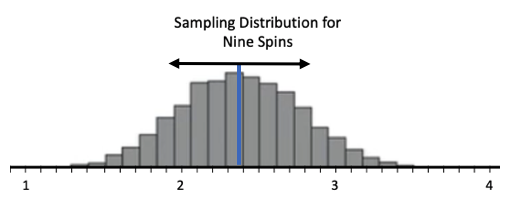This tutorial will focus on sampling error and how sample size relates to sampling error. Our discussion breaks down as follows:
1. Sampling Error
Sampling error simply relates to the variability within the sampling distribution. It is the amount by which the sample statistic differs from the population parameter.
-
EXAMPLE
Suppose that you have taken a sampling distribution of certain sizes from this spinner.

This would be a distribution where the number 1 occurs about three-eighths of the time, 2 occurs about one-eighth of the time, 3 occurs about two-eighths of the time, and 4 also occurs about two-eighths of the time.
These are the different sampling distributions.
You can see that their means are all the same. However, you can also notice that their standard deviations, which are the lengths of the arrows, decrease as the
sample size increases. That means that the larger the sample, the closer on average the sample statistic will be to the right answer. This also means that you will be closer to the population mean, represented by the blue line down the middle of the graphs above.
What you'll notice is that some of the sample means from samples of size 4 are way up near four or down near one, when the true population mean is two and three-eighths. Meanwhile, when you look at samples of size 20, the vast majority of these samples are between two and three--very close to the population mean of two and three-eighths. So, the distribution of sample means has a smaller standard deviation with a larger sample size.
-
The sampling error is an amount by which the sample statistic, like a sample mean, is off from the population parameter (a fixed value that we're trying to estimate). With larger samples, this sampling error decreases.
When we calculate a margin of error, we're approximating the sampling error. What’s being said is that our sample statistic is probably within a certain margin of error of the right answer, which we don't know.
-
EXAMPLE
Think of a poll that states that 60% of people are going to vote for a particular candidate for office. It's reported with a margin of error of 7%. So this is saying that the sample gave us 60%, but the real population proportion of people who are going to vote for that candidate is plus or minus 7%.
-
- Sampling Error
- The amount by which the sample statistic differs from the population parameter.
- Sample Size
- The size of a sample of a population of interest
2. The Effect of Sampling Size on Sampling Error
From no fault of yours, sampling error occurs when you use a statistic like a sample mean or sample proportion to estimate a parameter, like a population mean or population proportion. It's important to note, though, from the previous sampling distributions, is that since the sampling error decreases as the sample size increases, you would like as large a sample as possible.
-
Sometimes getting a large sample is precluded by practical concerns like money or time. Perhaps you simply don't have the money or time to take a large sample, so you are confined to a small sample. That is fine--just keep in mind that you would like a larger sample if you can get one.
An increased sample size has to be coupled with well-collected data. A large sample size does not rescue poorly-collected data. If your data are biased, you can't simply double the sample size and assume that everything will be okay, because there will be less sampling error. It doesn't work that way.
If the questions are poorly worded or there's non-response or other biases like response bias, then the data aren’t going to become any more accurate. They're not going to accurately approach the population parameters that you're trying to estimate by taking a larger sample.
-
Once you've collected your data poorly, you might as well throw it out. An increased sample size does not rescue it.
Sample statistics estimate population parameters. They do it more accurately when the sample size is large. Often, we don't know what the population parameter is, which is why we've taken the sample in the first place--to try and estimate the parameter. If the data were properly collected and the sample size is large--which is ideal--you can be fairly sure that the statistic that we get is close to the right answer, the parameter for the population. When you calculate a margin of error, you're approximating the sampling error.
Good luck!




